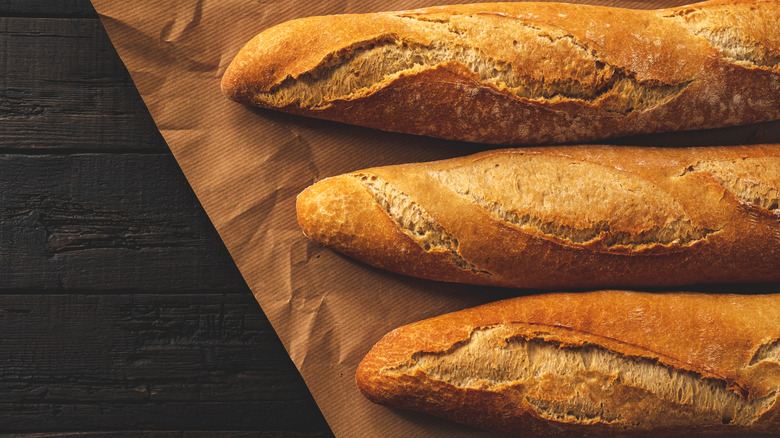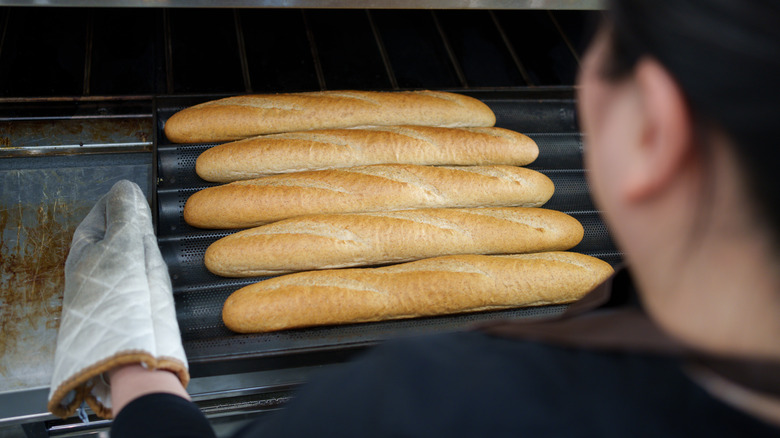Why Are French Baguettes So Long?
In France, a nation that stakes its identity on culinary greatness, no food is more iconic than a baguette. The lengthy loaf of bread is so important to the French identity that it was added to the UNESCO Representative List of the Intangible Cultural Heritage of Humanity in 2022. You would probably assume that baguettes have featured in the French diet for centuries, but in actuality, they've only been around for about a hundred years. The style first gained popularity in France around the late 1800s, and the word "baguette," which translates to "wand" or "rod," was not applied to the bread until the 1920s.
The origins of the baguette are shrouded in mystery. Shockingly, one popular theory attributes its invention not to a French baker, but to the Austrian August Zang. Zang, who is also credited with the origin of the croissant, opened a highly influential bakery in Paris in 1839. There is insufficient evidence to show that Zang actually invented baguette, but he did install the first steam oven in France, which would have been essential to developing the signature crisp crust and fluffy crumb of a quality baguette.
Throughout its history, the baguette's defining feature has always been its shape. It's what the name "baguette" alludes to, after all, and even before the current label came into use, people referred to these loaves as flutes, yet another reference to their shape. Everyone knows baguettes for their slender figure, and yet nobody seems to agree on why they are so long.
Many theories attempt to explain the baguette's shape
There is a popular legend that attributes the baguette's long shape to none other than Napoleon Bonaparte. It's said that Napoleon decreed that loaves of bread should be made long and slender so they would fit into his soldiers' coat pockets. However, unlike the invention of canned food, Napoleon probably doesn't deserve credit for this culinary invention, as concrete evidence for this theory is lacking.
Another popular theory points to 1793 amidst the French Revolution. The newly-formed government decreed, according to Britannica, "Richness and poverty must both disappear from the government of equality. It will no longer make a bread of wheat for the rich and a bread of bran for the poor. All bakers will be held, under the penalty of imprisonment, to make only one type of bread: The Bread of Equality." Many believe that this "bread of equality" was baguettes, but again, the proof is lacking.
The most out-there theory about the origins of the baguette's shape dates back to 1898 during the construction of the Paris Metro. Workers from all over France descended on Paris for the project, and violent conflicts broke out among them. To address this, it's said that bakers were ordered to create thin loaves of bread that could be torn by hand so the laborers wouldn't need knives.
The baguette's length is now defined by law
None of the theories behind the baguette's length has concrete proof behind it, and the world may never know for sure why this style was invented. However, it is known why baguettes became such a popular shape of bread in France beginning in the 1920s. During that decade, a law was made forbidding bakers from working between the hours of 10 p.m. and 4 a.m. This left them with very little time to bake before opening for business in the morning. Since the thin shape of baguettes allows them to cook faster than a round boule, this became the style of choice for French bakers.
Another law passed in the 1920s that set parameters for the size of baguettes. According to the rule, baguettes must weigh between 250 grams and 300 grams and may not exceed 65 centimeters (about 25.5 inches). Prior to this, baguettes could be as long as the baker desired, and there were even reports from the 1860s of baguettes that reached six feet in length.
In 1993, the French government passed another law, Le Décret Pain, which established concrete definitions for a number of French bread styles, including the baguette. According to Le Décret Pain, baguettes can only be sold on the same premises where they are made and can only contain four main ingredients: Wheat flour, water, salt, and a rising agent. The law also states that baguettes cannot be frozen and cannot use any preservatives (so it helps to know how to save a stale baguette).


